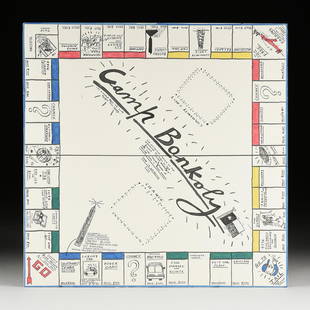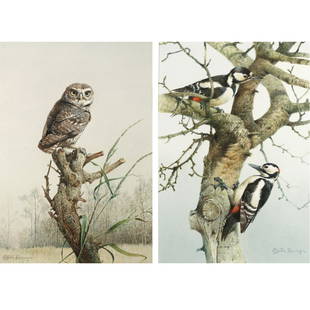
§ Geoffrey Clarke R.A. (British 1924-2014) Head I, 1951 (LeGrove S36)
Similar Sale History
View More Items in Mixed Media & CollagesRelated Mixed Media & Collages
More Items in Mixed Media & Collages
View MoreRecommended Art
View More





Item Details
Description
§ Geoffrey Clarke R.A. (British 1924-2014) Head I, 1951 (LeGrove S36) iron on aluminium, unique (18cm high (7in high)) Provenance Private Collection, UK. Exhibited Gimpel Fils, London, Geoffrey Clarke, Peter Potworowski, March - April 1952, no.41; Redfern Gallery, London, Geoffrey Clarke: Recent Sculptures, March - April 1965, no.49; Yorkshire Sculpture Park, Wakefield, Geoffrey Clarke RA: Sculpture and Works on Paper 1950-1994, April-June1994, illustrated on the cover. Literature LeGrove, Judith, Geoffrey Clarke Sculptor: Catalogue Raisonné, London: Pangolin and Lund Humphries, 2017, p.29, S36, illustrated. A cross on the top was missing by 1965 and has never been restored. Geoffrey Clarke: Intimate yet Monumental The works by Geoffrey Clarke offered here date from 1951 to 1993, spanning over forty years of his long and prolific career and representing a range of phases within his practice. What they have in common, however, is an intimate yet monumental character in which sculptures as modestly-sized as 10 centimetres high encapsulate a power and presence more readily associated with larger works. Head I of 1951 comes from an early series and was made whilst Clarke was studying at the Royal College of Art in London. Worked in iron, it reveals an exploration of Cubism and Surrealism with a frank appreciation of the materiality of his medium. Clarke graduated the following year, with his talent being immediately recognised with nothing less than his inclusion in the New Aspects of British Sculpture exhibition in the British Pavilion of the 26th Venice Biennale that summer. Clarke’s work was shown alongside that of seven other sculptors, namely Robert Adams, Kenneth Armitage, Reg Butler, Lynn Chadwick, Bernard Medows, Eduardo Paolozzi and William Turnbull. He was therefore positioned within the vanguard of post-war British sculpture and his career was launched to spectacular effect. Maquette for Sainsbury Sculpture Competition of 1965 fast forwards us to the mid-1960s, Clarke’s interest in public commissions and the associated use of cast aluminium; Ann Elliott has described the sandbox he built for this purpose in his studio foundry in Suffolk in 1954 (see Ann Elliott, ‘Clarke, Geoffrey Cyril Petts’, Oxford Dictionary of National Biography, on-line entry accessed 19/9/23). A totemic central element is crowned with a spiralling form whose upwards thrust is akin to organic growth. The varied surface treatment of the two parts is key to expressing the contrast between their presentations of mass and movement. Torrii Prone (i) and Toriio also date from 1965. As Peter Black has explained ‘The title ‘Torii’ applied to this series of sculptures derives from the ceremonial gateways to Japanese Shinto shrines. The essence of these works is the contrast between the inanimate slab of metal and the organic structures that bud and grow from the top.’ (Peter Black, Geoffrey Clarke: Symbols for Man, Sculptures and Graphic Work 1949-94, Lund Humphries, London, 1994, p.70). This series encompassed works based on vertical and horizontal formats in which Clarke explored a softened geometry combined with a curvaceous and rhythmic solidity. It is interesting to compare the organicism of these sculptures with Adams’s contemporary Vertical Form No. 1, an austere and imposing bronzed steel work made on a human scale and the suppleness of Bernard Meadows’ Pointing Figure of two years later. The Sea at Aldeburgh of 1978 is a particularly personal work. Clarke had close links to the Suffolk seaside town, not least owning its Martello Tower between 1967 and 1971; the tower and its surrounding topography fed into his work for some time. Made from mixed media applied to a small rectangle of polystyrene – more readily associated in Clarke’s practice with carving and the casting process – it is a simplified sea view in which the composition is split almost equally between sky and sea. Column and Pyramid both date from 1993. By this point in his career, Clarke had brought together formerly disparate elements to create sculptural planes enlivened by rich, deep-relief patterning which encases (or reveals) a raw core. Both works refer to significant architectural structures, whose power is yet retained in their modest scale. Clarke’s 70th birthday in 1994 was marked by several exhibitions, including a solo show at Yorkshire Sculpture Park which featured a cast of Head I on its catalogue cover. Ever interested in new materials, Clarke made his first work in wood in 1996 and, with an eye to his legacy, donated his archive to Leeds Museums and Galleries in 2012, two years before his death.
Buyer's Premium
- 31% up to £20,000.00
- 30% up to £500,000.00
- 25% above £500,000.00
§ Geoffrey Clarke R.A. (British 1924-2014) Head I, 1951 (LeGrove S36)
Estimate £1,500 - £2,500
2 bidders are watching this item.
Shipping & Pickup Options
Item located in London, England, ukSee Policy for Shipping
Payment

Auction Curated By

Modern British Art Modern & Post-War Design Contemporary & Post-War Art Decorative Arts: Design since 1860
Related Searches
TOP
















































































